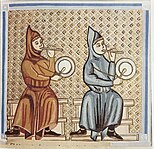
Bagpipes are a woodwind instrument using enclosed reeds fed from a constant reservoir of air in the form of a bag. The Great Highland bagpipes are well known, but people have played bagpipes for centuries throughout large parts of Europe, Northern Africa, Western Asia, around the Persian Gulf and northern parts of South Asia.

The tin whistle, also called the penny whistle, is a simple six-holed woodwind instrument. It is a type of fipple flute, putting it in the same class as the recorder, Native American flute, and other woodwind instruments that meet such criteria. A tin whistle player is called a whistler. The tin whistle is closely associated with Irish traditional music and Celtic music. Other names for the instrument are the flageolet, English flageolet, Scottish penny whistle, tin flageolet, or Irish whistle.

In Spain, music has a long history. It has played an important role in the development of Western music, and has greatly influenced Latin American music. Spanish music is often associated with traditional styles such as flamenco and classical guitar. While these forms of music are common, there are many different traditional musical and dance styles across the regions. For example, music from the north-west regions is heavily reliant on bagpipes, the jota is widespread in the centre and north of the country, and flamenco originated in the south. Spanish music played a notable part in the early developments of western classical music, from the 15th through the early 17th century. The breadth of musical innovation can be seen in composers like Tomás Luis de Victoria, styles like the zarzuela of Spanish opera, the ballet of Manuel de Falla, and the classical guitar music of Francisco Tárrega. Nowadays commercial pop music dominates.

The Galician gaita is the traditional instrument of Galicia and northern Portugal.
The low whistle, or concert whistle, is a variation of the traditional tin whistle/pennywhistle, distinguished by its lower pitch and larger size. It is most closely associated with the performances of British and Irish artists such as Tommy Makem, Finbar Furey and his son Martin Furey, Old Blind Dogs, Michael McGoldrick, Riverdance, Lunasa, Donie Keyes, Chris Conway, and Davy Spillane, and is increasingly accepted as a feature of Celtic music.
Northwest Iberian folk music is a traditional highly distinctive folk style, located along Spain's north-west Atlantic coast, mostly Galicia and Asturias, that has some similarities with the neighbouring area of Cantabria. The music is characterized by the use of bagpipes.

A fife is a small, high-pitched, transverse aerophone, that is similar to the piccolo. The fife originated in medieval Europe and is often used in fife and drum corps, military units, and marching bands. Someone who plays the fife is called a fifer. The word fife comes from the German Pfeife, meaning pipe, which comes from the Latin word pipare.
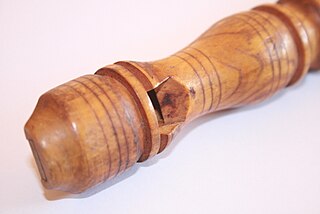
The term fipple specifies a variety of end-blown flute that includes the flageolet, recorder, and tin whistle. The Hornbostel–Sachs system for classifying musical instruments places this group under the heading "Flutes with duct or duct flutes." The label "fipple flute" is frequently applied to members of the subgroup but there is no general agreement about the structural detail of the sound-producing mechanism that constitutes the fipple, itself.

As Europe experienced a wave of roots revivals in the 1950s and 1960s, France found its regional culture reviving traditional music. Brittany, Limousin, Gascony, Corsica and Auvergne were among the regions that experienced a notable resurgence in the popularity of folk music. Traditional styles of music had survived most in remote areas, such as the island of Corsica and mountainous Auvergne, as well as the more nationalist lands of the Basques and Bretons.

The flabiol is a Catalan woodwind musical instrument of the family known as fipple flutes. It is one of the 12 instruments of the cobla. The flabiol measures about 25 centimeters in length and has five or six holes on its front face and three underneath.

A tabor, tabour, tabret, tambour de Provence, Provençal tambourin or Catalan tamborí is a portable snare drum, typically played either with one hand or with two drumsticks. The word "tabor" is simply an English variant of a Arabic-derived word meaning "drum"—cf. Catalan: tambor, French: tambour, Italian: tamburo Militaries may use the tabor as a marching instrument; it can accompany parades and processions.

A pipe is a tubular wind instrument in general, or various specific wind instruments. The word is an onomatopoeia, and comes from the tone which can resemble that of a bird chirping.

The fujara is a large wind instrument of the tabor pipe class. It originated in central Slovakia as a sophisticated folk shepherd's overtone fipple flute of unique design in the contrabass range.
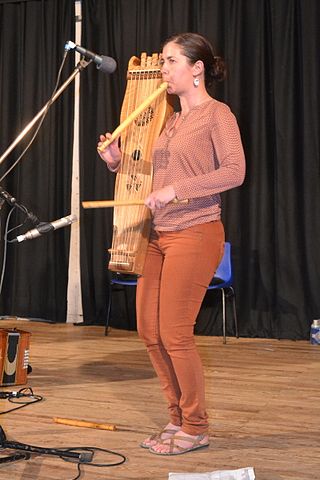
The string drum or Tambourin de Béarn is a long rectangular box zither beaten with a mallet. It is paired with a one-handed flute with three finger holes, similar to a pipe and tabor. It has also been called tambourin de Gascogne, tambourin à cordes in Catalan, Pyrenean string drum, ttun-ttun in Basque, salmo in Spanish, and chicotén in Aragonese. It was known in the middle ages as the choron or chorus.

The three-hole pipe, also commonly known as tabor pipe or galoubet, is a wind instrument designed to be played by one hand, leaving the other hand free to play a tabor drum, bell, psalterium or tambourin à cordes, bones, triangle or other percussive instrument.
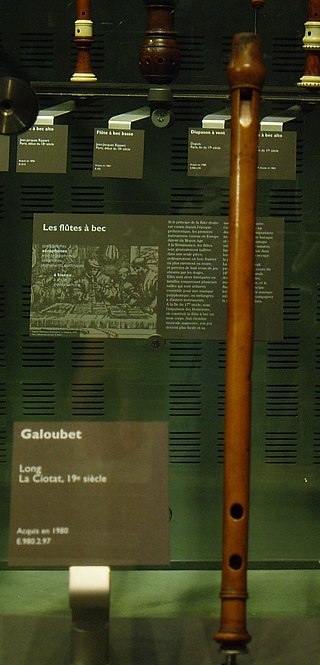
The xirula is a small three holed woodwind instrument or flute usually made of wood akin to the Basque txistu or three-hole pipe, but more high pitched and strident, tuned to D/G and an octave higher than the silbote. The sound that flows from the flute has often been perceived as a metaphor for the tweet cadences of bird songs. Some scholars point out that flutes found in the Caverns of Isturitz and Oxozelaia going back to a period spanning 35,000 to 10,000 years ago bear witness to the early presence of the instrument's forerunner in the region, while this view has been disputed.
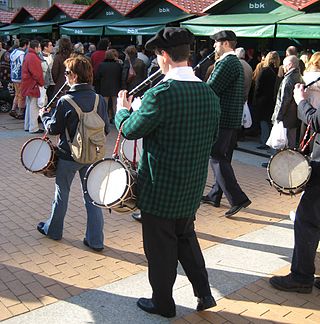
The txistu is a kind of fipple flute that became a symbol for the Basque folk revival. The name may stem from the general Basque word ziztu "to whistle" with palatalisation of the z. This three-hole pipe can be played with one hand, leaving the other one free to play a percussion instrument.

A kuisi is a Native Colombian fipple flute made from a hollowed cactus stem, with a beeswax and charcoal powder mixture for the head, with a thin quill made from the feather of a large bird for the mouthpiece. Seagull, turkey and eagle feathers are among the feathers commonly used.
The muiñeira is a traditional dance and musical genre of Galicia and some parts of Asturias (Spain). It is distinguished mainly by its expressive and lively tempo, played usually in 6
8, although some variants are performed in other time signatures. There are also variant types of muiñeira which remain in the tempo of 6
8 but which displace the accent in different ways. Muiñeira is associated with traditional choreographic schemes and the associated instrumentation is a form of bagpipe known as a gaita. It is subject to highly varied interpretation in differing local traditions. According to "Galicia-The Spanish Cousins", an article on Roots World, muiñeira is the Galician "equivalent" of a jig, which is consistent with the time signature of 6
8. The word "muiñeira" means literally both millstone and a mill landlady. Galician music is classified as part of Celtic music.

